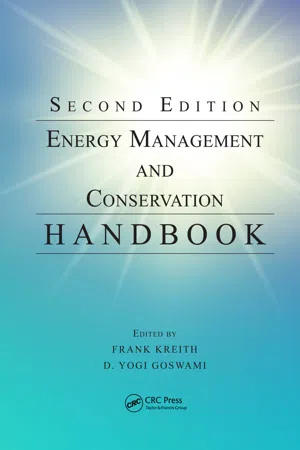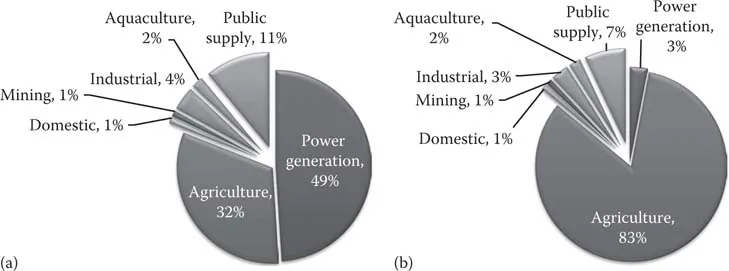1.1 Sustainability Principles in Management
The historic growth in all forms of energy use has led to unsustainable growth in population and the use of natural resources and land, as well as adverse environmental impact. Figure 1.1 shows the kind of interrelated issues that an engineer must consider in managing energy system investments. It is important to keep in mind that energy is not only an engineering challenge but also a politically and socially charged management field.
The energy choices made in the near future are among the most important of any choices in human history. Sustainability considerations reflect priorities in our society as well as our attitude toward future generations. Management of a sustainable energy future is only possible if we develop an overall technical, social, and political strategy that combines renewable energy development, energy conservation, and adaptation of our lifestyle to greatly reduce energy consumption (Kreith & Krumdieck, 2013; Rojey, 2009). One of the most important international studies of sustainable energy was the World Commission on Energy and the Environment headed by Gro Harlem Brundtland, the former prime minister of Norway, in 1983. The goal of this commission was to formulate a realistic proposal that allows human progress, but without depriving future generations of the resources they will need. The outcome of this study was summarized in an important book entitled Our Common Future (Brundtland, 1987); it concluded that the current development of human progress in both developed and developing countries is unsustainable because it uses an increasing amount of environmental resources, especially fossil fuels. The Brundtland Commission’s definition of sustainable development is as valid today as it was in 1983: “Sustainable developments should meet the needs of the present without compromising the ability of future generations to meet their own needs.” The traditional assumption of economists that when we run short of any one resource or material, engineers will always find a substitute is no longer valid for future planning.
FIGURE 1.1
Complex and interrelated nature of engineering, social, and environmental issues. (From Alliance for Water Efficiency and American Council for an Energy-Efficient Economy, Addressing the Energy-Water Nexus: A Blueprint for Action and Policy Agenda, May 2011; ASME, ETP: Energy-Water Nexus-Cross-cutting Impacts.)
1.2 Management of Common Resources
Key elements for the management of common resources are the allocation of resources that might become in short supply and the regulations that limit environmental impacts to protect public health. Allocations of limited water resources in California and Australia and punishment for people who pollute rivers and lakes are examples of such regulations. The last 30 years have seen a number of federal environmental legislations in the United States, for example, the Clean Air Act (1972) and the Safe Drinking Water Act (1974) have led to improvement in air and water quality. At present, many countries are considering legislation to limit the exhaust of carbon dioxide to avoid dangerous global warming that could adversely impact the environment. Energy engineers will be responsible for providing energy and services with current technology, while at the same time transitioning to more suitable systems. An example of the potential for such an approach is the 1987 Montreal Protocol on Substances that Deplete the Ozone Layer, substances that created an ozone hole above the Arctic. The protocol, which was ratified by most developed nations, required corporations to phase out production and use of hydrochlorofluorocarbons (HCFC), refrigerants that created the ozone hole. Engineers under pressure developed substitutes for HClF that have stopped the ozone hole from growing.
The most important lesson to learn from each experience is that in the past environmental regulations are developed after a problem arises when a technical alternative is available. There are many examples for this, such as the emission of pesticide DT and sulfur dioxide from coal fire power plants. The companies that were innovators of a transition technology, for example, electrostatic precipitators or catalytic converters, ahead of legal requirements were in a superior business position rather than those who fought the changes. One of the guiding principles for future sustainability management is to seek out scientific evidence and begin work on changing the existing processes before environmental regulations are enacted. Today, there are developing social businesses and B Corps that are for-profit companies that have social and environmental well-being as part of their objectives. Some corporations have hired sustainability managers even when there is no requirement for corporations to consider sustainability or social welfare. But consideration of sustainability is increasing in business and industry, and engineers capable of innovative and creative solutions are in short supply (Winston, 2014).
1.3 Water, Population, and Food Issues
Population growth, lack of food supply, and limited water resources are three issues that grossly affect the resource management challenges of the future. Although as shown in Figure 1.2 the rate of growth of world population has gone down, the actual number of people on the globe continues to increase. The United Nations predicts that global population will reach 9 billion by the year 2050, and even today with a global population of 7 billion, a large percentage of people, particularly in Africa and the Middle East, face lack of clean water and inadequate food supply. The world food production has increased substantially in the past century as has the calorie intake per capita, but the absolute number of undernourished people has increased considerably. It is estimated that almost a trillion are undernourished, and a continued increase in global population will increase food demand. Increased fertilizer application as well as water usage has been responsible for more than 70% of the crop yield increase in the recent past according to the UNEP (GRID-Arendal, n.d.), but cereal yield has nearly stabilized now and fisheries landings have decreased in the past decade mainly as a result of overfishing and unsound fishing methods. About 30 million tons of fish needed to sustain the growth in aquaculture correspond roughly to the amount of fish discarded at sea with current fishing methods. An extensive study providing recent data and findings from a range of international collaborations and studies can be found in Martindale (2014).
FIGURE 1.2
Annual additions and the annual growth rate of global population. (From Population Division of the Department of Economic and Social Affairs of the United Nations Secretariat, World population prospects: The 2008 revision, March 2009, http://esa.un.org/unpp.)
Although there is an enormous amount of water on the planet, less than 1% is usable for drinking and agriculture; the rest is salty, brackish, or frozen. Freshwater refers to rivers or lakes fed by seasonal precipitations. Aquifers are underground freshwater reservoirs in permeable gravel or sand. Some of these, called unconfined, are replenished by surface precipitation. But others, called confined aquifers, such as the massive Ogallala Aquifer under the Great Plains of the United States, are actually finite and were deposited over a million years ago. Confined aquifers have a finite lifetime and some of them have already run dry. A recent study found that at least 30% of the southern Great Plains will exhaust their ground water reserve within the next 30 years (Scanlon et al., 2012).
The World Health Organization stipulates that the basic requirement for water is 20 L per day per person and that it be accessible within 1 km of the user. In industrial societies, personal water consumption is considerably larger, and if industrial and energy production are added, freshwater usage can exceed 5000 L per day per capita, and water scarcity in a developed country is equivalent to an annual availability of less than 1000 m3 per person (World Bank, 2003).
The biggest user of freshwater from lakes and rivers are cooling towers of electrothermal power plants. A majority of power plants operate on the Rankine cycle and they need cooling water in the condensers to operate. Although much of the water used by power plants is returned to rivers or lakes, the returned water is warmed to between 4°C and 10°C and the upper regulation of temperature rise is necessary to protect aquatic ecosystems. But 3% of all US water consumption is evaporated from the cooling towers of power plants and lost as water vapor into the atmosphere. Figure 1.3 shows a breakdown of the water withdraws and consumption according to a recent study (ASME, 2011).
Although the technology for desalination is well known, the process requires a very large amount of energy. There are more than 7000 desalination projects in operation, with 60% located in the Middle East. The levelized cost of water from desalination plants is about $0.60 per m3 for large plants and considerably higher for smaller ones. Thermal processes like multistage desalination (MFD) use 10–15 kWh/m3 of water, while reverse osmosis (RO) uses between 1 and 2.5 kWh/m3 for brackish water and 4–13 kW/m3 of electricity for seawater (Loupasis, 2002). Water desalination can be a source of fresh drinking water in parts of the world that have excess energy, but it is not a solution to the forthcoming water crisis as the population grows.



